| Article ID | Journal | Published Year | Pages | File Type |
|---|---|---|---|---|
| 1232769 | Spectrochimica Acta Part A: Molecular and Biomolecular Spectroscopy | 2012 | 9 Pages |
CdSiO3:Dy3+ (1–9 mol%) nanophosphors were prepared for the first time using the solution combustion method. The process of monoclinic phase formation was investigated by PXRD, TG–DTA and FTIR. The results show that the phase formation temperature of combustion-derived monoclinic CdSiO3 is found to be lower as compared to the powders prepared by solid-state and sol–gel methods. It was observed that the average crystallite size calculated by Debye–Scherrer's formula and Williamson–Hall (W–H) plot are well comparable and was found to be in the range of 35–70 nm. Scanning electron micrographs indicate that there exist circular microcrystalline particles. It is observed that the optical energy gap is widened with the increase of Dy3+ ion dopant. The photoluminescence (PL) spectra exhibit characteristic transitions of Dy3+ due to 4F9/2 → 6H15/2 (blue) and 4F9/2 → 6H13/2 (yellow) regions. The thermoluminescence (TL) glow curve of CdSiO3:Dy3+ nano powder exposed to UV irradiation exhibited one main peak centered at 170 °C. The intensity of the main peak increases up to the dose of 20 min then it decreases. The glow curves were analyzed by the glow peak shape method and the estimated trap parameters are discussed.
Graphical abstractTL glow curves of UV irradiated CdSiO3:Dy3+ (a)10 min, (b) 20 min, (c) 30 min, (d) 40 min and (e) 50 min at an heating rate of 5 °C/s.Figure optionsDownload full-size imageDownload as PowerPoint slideHighlights► CdSiO3:Dy3+ nanophosphors have been prepared at much lower temperatures. ► SEM reveals that there exist some novel cobblestone-like microcrystalline particles. ► Phosphors are well characterized by PXRD, TEM, FTIR and UV–vis spectroscopy. ► Thermo and photoluminescence properties were also reported.
